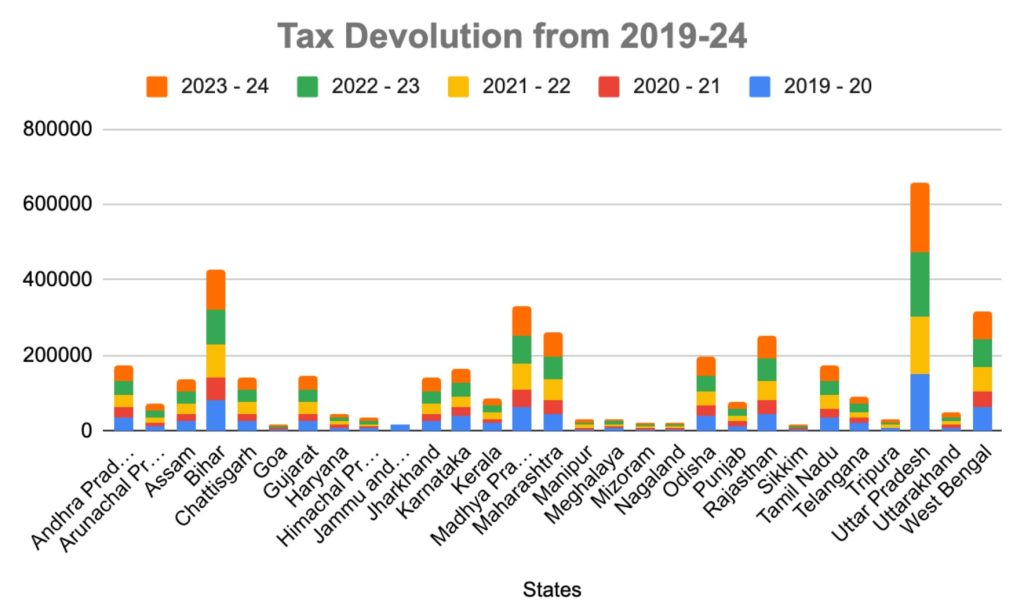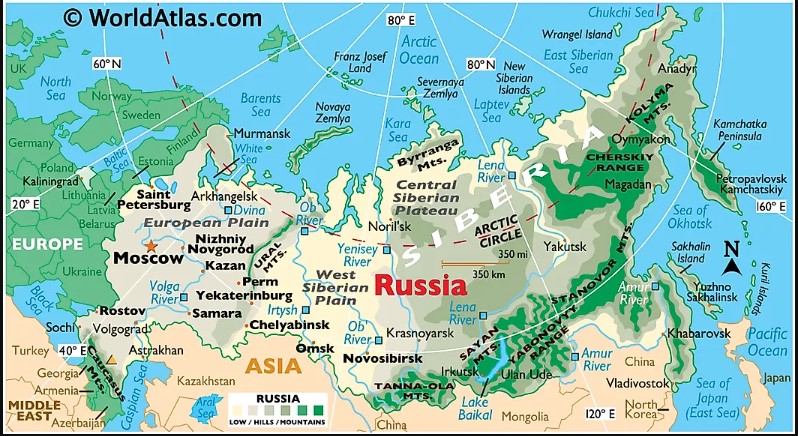CONTENTS
- The Union Government’s Rein on Financial Transfers to Different States
- India-Russia Summit Revives Relations Amid Global Tensions
The Union Government’s Rein on Financial Transfers to Different States
Context:
Since the beginning of the Fourteenth Finance Commission’s award period in 2015-16, the Union government has been reducing financial transfers to the States. This is surprising, given that the Fourteenth Finance Commission recommended increasing the States’ share of Union tax revenues to 42%, a 10 percentage point rise from the Thirteenth Finance Commission’s recommendation.
Relevance:
GS2-
- Functions and Responsibilities of the Union and the States
- Issues and Challenges Pertaining to the Federal Structure
- Devolution of Powers and Finances up to Local Levels and Challenges Therein
GS3-
- Indian Economy and issues relating to Planning
- Mobilization of Resources
- Growth, Development and Employment
- Inclusive Growth and issues arising from it
Mains Question:
Despite the Fourteenth Finance Commission’s recommendation of increasing the States’ share of Union tax revenues from the Thirteenth Finance Commission, the recent years have seen a reduction in financial transfers to states. Examine the validity of this statement and the reasons behind this occurrence. (15 Marks, 250 Words).
Reduced Financial Transfers to States:

- The Fifteenth Finance Commission maintained a similar recommendation of 41%, excluding Jammu and Kashmir (J&K) and Ladakh, which were reclassified as Union Territories. Including J&K and Ladakh, the share would be 42%.
- Despite this, the Union government not only reduced financial transfers to the States but also increased its own total revenue for discretionary spending.
- These discretionary expenditures are not routed through State Budgets, which can affect different States in various ways.
- The Finance Commissions recommend the States’ share of the net tax revenue of the Union government.
- While the Fourteenth and Fifteenth Finance Commissions recommended that 42% and 41% of the net tax revenue, respectively, be allocated to the States, the States’ share of the gross tax revenue was only 35% in 2015-16 and 30% in 2023-24 (Budget Estimate).
- Although the Union government’s gross tax revenue increased from ₹14.6 lakh crore in 2015-16 to ₹33.6 lakh crore in 2023-24, the States’ share rose from ₹5.1 lakh crore to ₹10.2 lakh crore during the same period.
- This means that while the Union government’s gross tax revenue more than doubled, the States’ share only doubled.
- Additionally, grants-in-aid to States, another statutory grant recommended by the Finance Commission, decreased from ₹1.95 lakh crore in 2015-16 to ₹1.65 lakh crore in 2023-24.
- One reason for the declining share of States in gross revenue during this period is the calculation of net tax revenue, which is derived after deducting revenue collections from cess and surcharge, Union Territories, and tax administration expenditures.
- Among these factors, cess and surcharge revenue collection is the highest and has been increasing.
- In 2015-16, cess and surcharge collections were 5.9% (₹85,638 crore) of the Union government’s gross tax revenue, rising to 10.8% (₹3.63 lakh crore) in 2023-24.
- This excludes the Goods and Services Tax (GST) cess, which was collected to compensate for the States’ revenue loss due to GST implementation until June 2022.
- The Union government has been increasing tax collection under cess and surcharge categories mainly to fund its own schemes in specific sectors, and these revenues do not need to be shared with the States.
Increased Centralization of Public Expenditure:
- When financial transfers to States, whether as tax devolution or grants-in-aid, decline or fail to increase in proportion to the Union government’s gross revenue, the Union government ends up with more discretionary funds.
- This can affect the equitable distribution of financial resources among States.
Union Government’s Methods of Direct Financial Transfers to States:
- The Union government employs two primary methods for direct financial transfers to States: Centrally Sponsored Schemes (CSS) and Central Sector Schemes (CSec Schemes).
- Through CSS, the Union government influences State priorities by providing partial funding, with the States required to contribute the remaining portion.
- Essentially, the Union proposes the schemes, and the States implement them, committing their own financial resources as well.
- From 2015-16 to 2023-24, CSS allocations increased from ₹2.04 lakh crore to ₹4.76 lakh crore across 59 schemes.
- Consequently, the Union government compels States to commit nearly equivalent financial resources.
- However, the actual financial transfers to States under CSS were only ₹3.64 lakh crore in 2023-24, with nearly ₹1.12 lakh crore retained by the Union government for other expenses.
- An important aspect of CSS is that only States that can afford to match the finances from their budgets can avail themselves of the grants. This creates disparities in inter-State equity in public finances.
- Wealthier States can leverage Union finances by committing matching funds, while less wealthy States may have to rely on borrowed finances, increasing their liabilities.
- This results in divergent financial trajectories among States, with CSS being a major contributing factor to inter-State inequality in public finances.
- CSec Schemes are fully funded by the Union government in sectors where it has exclusive legislative or institutional control.
- The Union government may allocate financial resources to benefit specific States or constituencies through these schemes.
- The combined allocation for CSS and CSec Schemes in 2023-24 is ₹19.4 lakh crore, with only ₹4.25 lakh crore devolved to States.
Potential for Anti-Federal Fiscal Policies:
- Financial transfers through CSS and CSec Schemes are non-statutory, as they are not based on legal provisions or any formula set by the Finance Commission. These non-statutory grants make up 12.6% of the gross tax revenue.
- Combined with statutory grants, total financial transfers were only 47.9% of the gross tax revenue in 2023-24.
- Moreover, non-statutory grants are tied grants, meaning they must be spent on specific schemes for which the funds are allocated. This limits the States’ autonomy in public expenditure.
- In addition to retaining more than 50% of the gross tax revenue, the Union government also incurs a fiscal deficit amounting to 5.9% of GDP, giving it significant financial power with limited expenditure responsibilities.
Conclusion:
The Fifteenth Finance Commission noted that the Union government argued for reducing the States’ share of Union tax revenue from 42%, and the Commission ultimately retained the share at 41%. The Union government may use the same argument, citing higher expenditure commitments, before the Sixteenth Finance Commission. So much for cooperative federalism!
India-Russia Summit Revives Relations Amid Global Tensions
Context:
Just as there was a growing perception that India-Russia ties were losing momentum, the summit between Prime Minister Narendra Modi and President Vladimir Putin has injected new energy into their bilateral relations.
Relevance:
GS2-
- Bilateral, Regional and Global Groupings and Agreements involving India and/or affecting India’s interests
- Effect of Policies and Politics of Developed and Developing Countries on India’s interests, Indian Diaspora
Mains Question:
The India-Russia Summit underscored India’s strategic balancing act between global powers while prioritising its own economic and security needs. Discuss. (10 Marks, 150 Words).
Revitalizing India-Russia Relations Amid Geopolitical Tensions:

- Held after a gap of over two years, amid ongoing geopolitical turbulence, the 22nd summit demonstrated both sides’ commitment to unlocking the full potential of their strategic partnership.
- The outcomes of the summit highlighted New Delhi’s intention to maintain strong ties with Moscow despite widespread Western criticism of Putin following Russia’s invasion of Ukraine and the subsequent sanctions.
- With Putin preoccupied with the ongoing Russia-Ukraine conflict, now into its third year, summit-level meetings had been on hold. The last summit took place in New Delhi in December 2021.
- The recent summit showed eagerness from both countries not only to rejuvenate the ‘Special and Privileged Strategic Partnership‘ but also to make economic cooperation a cornerstone of their relationship.
- This was underscored by a joint statement outlining nine key areas for economic collaboration, with a new bilateral trade target of $100 billion set for 2030.
- Although Ukrainian President Volodymyr Zelenskyy expressed disappointment, calling it a blow to peace efforts, it is unlikely to affect New Delhi’s close ties with Kyiv.
- While India has not condemned the invasion, Modi did tell Putin that “there is no peace on the battlefield,” reiterating India’s stance on the need for dialogue.
- Despite Washington’s displeasure over the Modi-Putin meeting, it is unlikely to impact the trajectory of India-US relations, driven by India’s strategic needs. One of these needs is managing the growing Russia-China alliance.
- Strengthening ties with Russia also addresses Moscow’s concerns over New Delhi’s tilt towards Washington.
- India has so far managed a delicate balance between these geopolitical rivals and is likely to continue doing so.
India’s Strategic Partnership with Russia Amid Western Sanctions:
- India views Russia as a long-standing, trusted partner. Despite Western efforts to isolate Russia due to the Ukraine war, India’s drive for deeper economic ties reflects its strategic interests.
- India’s imports of Russian oil, vital for its energy security, have surged from 2.5 million tonnes in 2021 to 90 million tonnes in 2023.
- Investments in the energy sector remain a priority, and fertilizer imports from Russia are crucial for India’s agriculture.
- These oil imports have boosted bilateral trade to $65.70 billion, though Indian exports were only $4.26 billion compared to $61.44 billion in imports.
- While benefiting from discounted Russian oil, India needs to address this trade imbalance by diversifying its export portfolio, which currently includes pharmaceuticals, organic chemicals, iron and steel, and electrical machinery.
- Both countries have agreed to explore eliminating non-tariff trade barriers and establishing a Eurasian Economic Union (EAEU)-India Free Trade Area, indicating a strong commitment to enhancing trade.
- The initiation of full negotiations for a free trade agreement between India and the EAEU should further boost trade relations.
- Connectivity is also a priority for both nations, aiming to facilitate access for Indian goods to Eurasian markets. However, the proposed International North-South Transport Corridor (INSTC) is still far from realization.
- Renewed interest in the Chennai-Vladivostok Maritime Corridor, first proposed in 2019, also remains to be actualized.
- The summit emphasized robust cooperation in the defense sector, a critical component of India’s security framework.
- Despite efforts to diversify arms suppliers, Russia remains India’s largest provider. India likely addressed concerns over delays in Russian military hardware and spare parts due to the Ukraine war.
Conclusion:
While the Modi-Putin Summit may have angered the West, it’s clear that New Delhi will prioritize its strategic needs.



